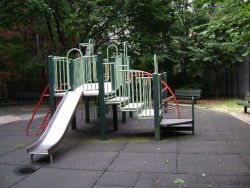Berry Playground
Berry Playground
In 1861, at the beginning of the Civil War, Dr. Berry enlisted as a surgeon in the 38th New York Infantry, although he was already over 60 years old. When General McClellan retreated to Harrison’s landing in July 1862, Dr. Berry had more than 300 patients in his care. When the army moved on, they forgot about the doctor and his patients and left them all behind. Dr. Berry was forced to carry all the sick and invalid patients to the James River, and by the time he got them there, his band had swelled to over 800. His death in Williamsburg on October 2, 1865, was the result of a fever he contracted during that time.
Williamsburg was originally contained in the Dutch town of Bushwick. It was named in 1810 for the original surveyor of the site, Colonel Jonathan Williams. Richard Woodhull purchased the area in 1802, and, intending to market it as a peaceful residential area for Manhattan workers, he began a ferry service between Brooklyn and Manhattan. Although his idea did not take off until Berry implemented it, the area became so well populated by 1852 that it was chartered as a city, only to be annexed by Brooklyn in 1855.
During the mid-1800s, wealthy professionals frequented the private clubs, beer gardens, and resorts abounding in Williamsburg, while companies such as Pfizer Pharmaceutical and Domino Sugar Refineries planted their roots in the neighborhood. The opening of the Williamsburg Bridge in 1903 provided an easy route for the city’s newest Eastern European immigrants to leave the cramped Lower East Side of Manhattan, and by 1917 Williamsburg was the most densely populated area of Brooklyn.
The city acquired the land for Berry Playground for $18,000 from the Brooklyn Eye and Ear Hospital in 1936. It immediately came under the jurisdiction of Parks, and opened shortly thereafter. In 2000, Council Member Victor L. Robles funded a $585,000 reconstruction of Berry Playground. A new spray shower now provides cool relief in the summer, while colorful new play equipment on safety surfacing for school-age children and new swings for tots offer recreation for everyone. Animal art, reflecting a bear surrounded by bayberry shrubs, and colored cement make Berry Playground a cheerful oasis for kids, and parents and caretakers now have new benches to rest on under the shade of newly planted trees.
Check out your park's Vital Signs
Clean & Safe
Green & Resilient
Empowered & Engaged Users
Share your feedback or learn more about how this park is part of a
Vital Park System


